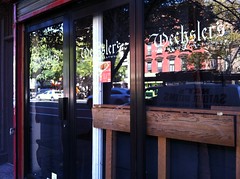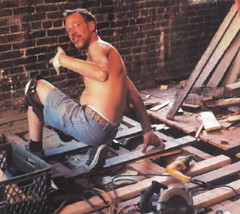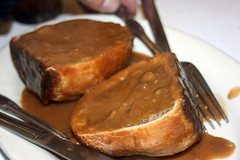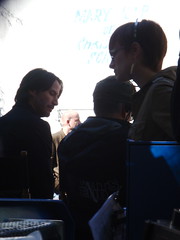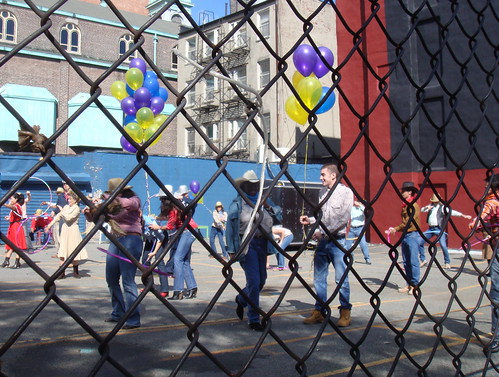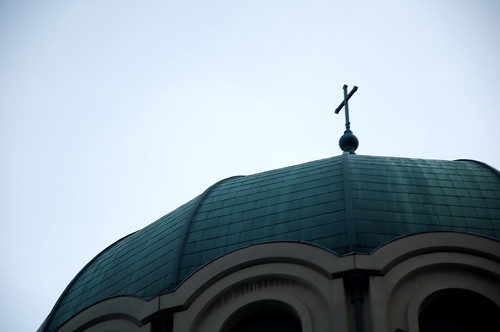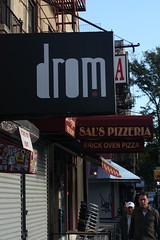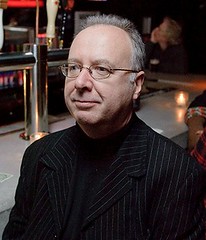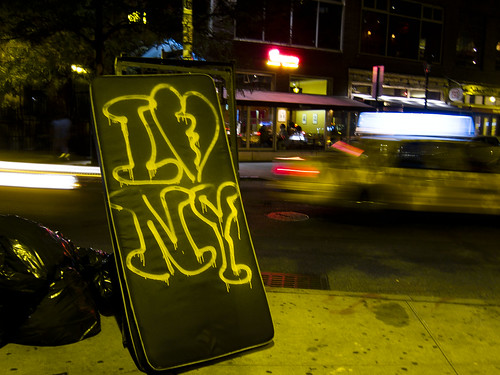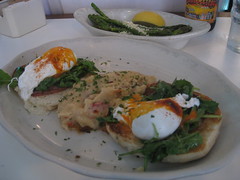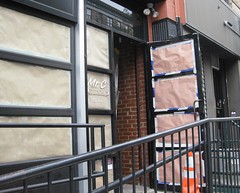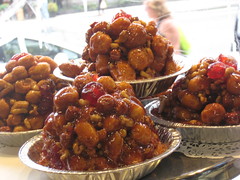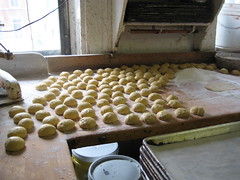It was the second-to-last day of Oktoberfest at Wechsler’s, a midget wursthaus — more like a wurstkiosk — at 120 First Avenue, between Seventh Street and St. Marks Place. Andre Wechsler, the eponymous owner, had his barman/waiter/busboy pour a draft of Schneider Weisse beer and another of Radeberger Pilsener. Each arrived in a glass from its own brewery. It would be an insult to Andre to say the foam on each was just so — of course it was. Still, my friend Birte Kleemann, who ran an art gallery in Berlin before becoming director of The Pace Gallery in Chelsea, had a probing question: “Are these German strength, or American?” The typical alcohol level of German beer, Birte explained to me, was 5.45 percent, slightly above the strength of the dishwater served in this country. Andre solemnly averred that the provenance of both was pure German. “Actually,” he added, “the Schneider Weisse is 6.2 percent—special for Oktoberfest.”
Read more…
LIFE
Bratwurst With Birte at Wechsler’s
By JAMES TRAUBAll About Parkour
By AL KAVADLO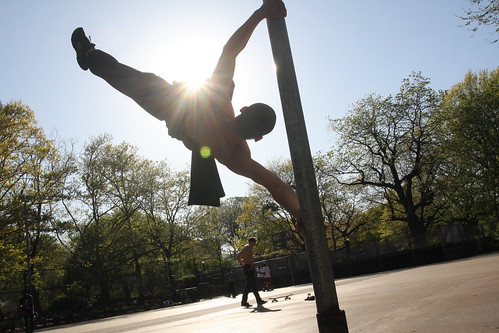 Darren Tobia Angelo Cabrera, 19, from the East Village performs “the flag” in Tompkins Square Park. He is a member of the NYC Parkour team, which performs gymnastic maneuvers against an urban backdrop.
Darren Tobia Angelo Cabrera, 19, from the East Village performs “the flag” in Tompkins Square Park. He is a member of the NYC Parkour team, which performs gymnastic maneuvers against an urban backdrop.The Local East Village takes a look at the fitness phenomenon known as parkour through a pair of reports. First, Community Contributor Al Kavadlo, a personal fitness trainer, offers a first person account where he tries out some parkour moves. Then, NYU Journalism’s Lesley Messer and Suemedha Sood report on four neighborhood teenagers who’ve formed a bond through their practice of the sport.
What began with a group of teens in France running and jumping through the city streets has turned into a worldwide fitness movement, with the East Village as one of NYC’s primary hubs. Tompkins Square Park has had a reputation for many different things over the years. You can now add parkour to the list.
Parkour involves training to overcome physical obstacles by adapting to the environment. If there is a ledge, you vault over it, if there is a tree, you climb it and if there is a gap, you jump it.
Read more…
Mourning Michael Shenker
By DYAN NEARYMichael Shenker, a homesteader and long-time community activist in the East Village, died Saturday of liver failure at the age of 54. NYU Journalism’s Dyan Neary, a friend of Mr. Shenker’s, prepared this first-person recollection of his life and the morning of his death.
I wake with a start at 7:25 a.m., sucking air through my lips with a slow whistle and blowing it out again. Nikita is waving at me from her crib. I feel reinvigorated somehow.
It is 7:25 a.m. and I want to apologize to everyone I have ever harmed, even in the smallest of ways. I write an e-mail to Brian, a masterful exercise in humility and accountability. For being a stress case and for being difficult when I was pregnant. I read several books to my daughter.
At 10:30 I gently unroll the down comforter to reveal Brian’s sleeping face. Out the window, I can see so much of the skyline, buildings stacked upon buildings and the Empire State climbing higher than all of them now, the centerpiece to a misshapen staircase like a three-dimensional collage of various shades of tawny overlapping tan.
I’m going to see Michael in the hospital, I tell Brian. Nikita has been changed, fed, read to. I place a kiss on his forehead. Check your e-mail.
Read more…
The Art and Mystery of Jim Joe
By MAYA MILLETT Maya MillettThe graffiti artist Jim Joe is known both for his ubiquity and the simplicity of his style.
Maya MillettThe graffiti artist Jim Joe is known both for his ubiquity and the simplicity of his style.If you’ve walked around the East Village lately, chances are you’ve seen two words set in a declarative scrawl on the grit of concrete: JIM JOE.
His presence within the neighborhood is virtually everywhere — there’s JIM JOE written on the side of a building on the Bowery; JIM JOE written in chalk on a dumpster on East Fourth Street and Avenue A — yet his ubiquity and deft use of social media to promote his projects have helped him cultivate an aura of mystery and elusiveness beyond that of many other taggers.
“I MISS YOU BUT I CANNOT BEAR TO LOOK YOU IN THE EYES,” he wrote in an e-mail exchange with The Local, one of his rare responses to requests for comment from the public. “I WOULD PREFER NOT TO BE SEEN.”
Read more…
In Search of the Perfect Knish
By C.C. GLENNTraditionalists argue whether a knish should be round or square, baked or fried, but what about blueberry or chocolate cheese? Is a knish truly a knish if it’s not a savory potato snack?
In search of a culinary adventure on Tuesday night, a couple dozen knish veterans, newbies and plain epicurious folks met in Tompkins Square Park to embark on NYC Food Crawl’s newest installment – a quest for the perfect knish.
Like a giddy camp counselor, Amanda Gilmore organized teams with captains, doled out maps of knish stops and gave out tips to crawlers while standing atop a gate post. “It’s all about going at your own pace,” said Ms. Gilmore, one of the founders of NYC Food Crawl. “Patience is generally key.”
Read more…
Keanu Reeves and Cowboy Hats
By SOPHIE HOELLER and SALLY LAUCKNER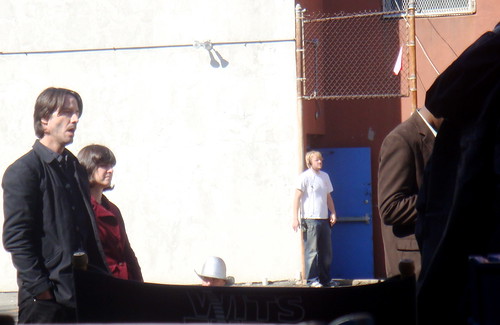 Sophie Hoeller Keanu Reeves on the set of “Generation Um…” at 11th Street and Avenue A this morning.
Sophie Hoeller Keanu Reeves on the set of “Generation Um…” at 11th Street and Avenue A this morning.Hula-hoops, cowboy hats, denim jackets and glitter filled a courtyard at 11th Street and Avenue A this morning. Dozens of extras were in the midst of filming a “flash mob” scene — a random assembly of people performing a planned bizarre act — for “Generation Um…” a new movie starring Keanu Reeves.
Unfazed by the colorful scene in front of him, the star was on site, looking bored between takes. He channeled his “Matrix” character, Neo, by wearing black from head-to-toe.
While getting touched up by hair and makeup, Mr. Reeves gave an autograph to an excited fan named Elias.
The indie drama follows John (Reeves’ character’s unconfirmed name) and two friends (played by actresses Bojana Novkovic and Adelaide Clemens) through “a world of sex and drugs…and chaos,” according to Cinemablend.com. The film is being made by Voltage Pictures, the studio that produced “The Hurt Locker.”
The flick has been filming in the East Village for the past two days, at locales such as AlphaBet Café. A crewmember confirmed that this would be their last day at this location. The movie, which is set in LA, has also been filming in Greenpoint, Brooklyn.
For These Faithful, A Makeshift Temple
By TIMOTHY J. STENOVECAs a hub of the Hare Krishna Movement in America, the East Village is a special place for followers of the Hindu sect.
But a small number of followers, calling themselves the Iskcon Revival Movement, splintered from the more mainstream religion and established their own temple on St. Marks Place in 1999, only to lose the lease last year.
Now, with nowhere else to go to practice their religion, Vani and Brahmabuta-Das Wulfhoop operate a makeshift temple inside their East Village apartment.
Conversation | On Landmarks
By THE LOCALJust before the weekend, we posted a story about the debate over granting a landmark designation to a Russian Orthodox church on Second Street.
The piece was also referenced on nonconforminguse.com, a blog focused on land use issues.
And here at The Local, one reader, Isaac Bass, noted that the landmark dispute is “an issue that wasn’t black and white and had many facets. It left me pondering the merits of both sides of the argument and how it may be resolved in a so-called win-win way.”
We’d like to hear your thoughts about landmark designations and if you think there are any solutions that could be, as Mr. Bass noted, win-win.
A Venue Returns to Its Roots
By JOE PUGLISIDrom, the world music venue on Avenue A, is undergoing rebirth after several months closure.
The club exists down some stairs set back in a building between Fifth and Sixth Streets, so it’s easy to miss. The entryway, usually crowded with bar-hoppers, is gated during the day, with only a sign to indicate its location. Some may have assumed it had closed for good.
Drom was founded three years ago by Serdan Ilhan, a seasoned music producer from Istanbul. According to Mr. Ilhan, Drom started as a stage for “world music, especially gypsy music.” Gypsy style, originating with the Romani people of Eastern Europe but now a global phenomenon, is essentially a blend of European and Indian folk styles.
Mr. Ilhan has been involved in the music business since 1994, working with world music events at Lincoln Center and Summerstage. He has also toured with several acts. But operating a venue is his main passion. Drom is the third in a series of attempts to curate a stage in the East Village. “I’ve been in the business a long time,” Mr. Ilhan said. “And venue and the music are together for me.”
Read more…
A Look at Prohibition’s Local Past
By MAYA MILLETT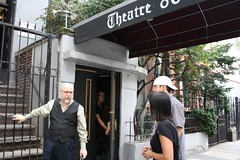 Maya Millett Lorcan Otway guides a tour of prohibition enthusiasts towards the gangster museum, located on the upper level of Theater 80.
Maya Millett Lorcan Otway guides a tour of prohibition enthusiasts towards the gangster museum, located on the upper level of Theater 80.Long before the Beat poets, the Warhol kids, free-spirited artists and musicians came to define the East Village’s bohemian scene, a different kind of character dominated the streets: the neighborhood bootlegger.
During the height of the 1920s Prohibition era, New York City served as the American gangster’s playground. Behind ordinary storefronts and in dingy back alleyways, men and women thirsty for forbidden libations and the prospect of a good time crept up to nondescript doors and slipped into another world. At the height of the Jazz Age, America was ready to dabble in debauchery even in the East Village, where European immigrant families crowded into tenement buildings.
Unlike the glamorous settings depicted on the new HBO series “Boardwalk Empire” the face of the speakeasy owner here was often not a wily gangster, but a German shopkeeper or a Jewish teacher. For these East Villagers, starting a speakeasy was as easy as opening their homes for an afternoon to sell alcohol. The illegal booze was snagged through a number of enterprising means — whether through dealings with a local bootlegger or grabbing what they could from a stalled truck transporting the stuff. “It was just kind of a buyer’s market — bootleggers were slipping menus underneath doors like Chinese food menus.”
Read more…
Opinion | The Noise Debate
By KIM DAVISWhat legitimate expectations does the community have of bar and club-owners when it comes to noise? And just which community are we talking about? I wanted to remove my editorial hat for a moment and join this conversation from a personal perspective.
Of course we can have legitimate expectations when it comes to how the nightlife industry conducts itself. The owners should be held responsible for behavior inside bars and clubs, for the level of noise emanating from the premises, and for what happens right on their doorstep. In particular, they should be held accountable if they serve liquor to guests who are already intoxicated: illegal, of course, but a law hardly ever enforced.
They cannot, however, be held responsible for policing the streets of the East Village. It was the city, remember, who decided that smokers should congregate outside licensed premises, with the result that late-night conversations once held behind closed doors are now held on the sidewalk.
Beyond posting friendly reminders to keep the noise down, what can bar and club owners do? They have no authority to impose silence on the streets; they can’t control the behavior of customers who have left their premises; and they certainly can’t stop cabs sounding their horns.
But just who is being disturbed by late-night street life? I’ve lived between Avenues C and D for ten years, and my neighbors aren’t complaining about noise from clubs. They can’t hear it over the music they’re blasting themselves. What’s more, long-term residents of the blocks east of Avenue A are for the most part happy to see bright lights and nightlife replace the dark storefronts of the past. As the urbanist Jane Jacobs taught, empty, silent streets are hospitable to criminality.
Is it noise that’s really what bothers some segments of the community? Or is it change? Is it the sense that the people making the noise (visitors to the neighborhood, students) don’t really belong? Is this supposed issue really a peg on which to hang prejudices and a sort of inverted snobbery: keep out of my East Village – you’re not welcome?
Kim Davis is the community editor of The Local East Village.
On 7th Street, An Unusual Veranda
By ALEXANDRA DIPALMAIt’s Time on 7th from Alexandra DiPalma on Vimeo.
On most days, Anthony Pisano sits outside of what appears to be a quirky store window display, complete with a neon sign that reads, “It’s time on 7th.” Music (usually Frank Sinatra) pours out of industrial-sized speakers onto the sidewalk on Seventh Street near First Avenue; Mr. Pisano chats with passers-by, urging them to go inside and “satisfy their curiosity.”
Considering the cases of old watches and vast array of other miscellaneous collectibles that are found inside, most visitors assume that they are entering an antique shop or gallery. But it’s not a store and nothing is for sale. The narrow, crowded space has been Mr. Pisano’s apartment for than 32 years.
Harry’s Last Day in the Park
By TIMOTHY J. STENOVEC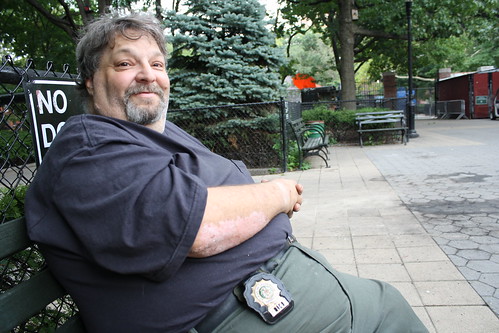 Timothy J. Stenovec Harry Greenberg retires today after 22 years as the supervisor of Tompkins Square Park.
Timothy J. Stenovec Harry Greenberg retires today after 22 years as the supervisor of Tompkins Square Park.Harry Greenberg remembers the moment Tompkins Square Park changed. It was the winter of 1992, and the Friends of Tompkins Square, a now defunct civic organization, planted a pine tree on the eastern side of the park’s central lawn. In the first of what has become an annual caroling celebration, community members adorned the tree with lights and decorations. If recent history were any indication, that tree and its ornaments should have been stripped down and hocked by the park’s homeless, the fate countless park plants had already suffered. But miraculously, the tree—and the decorations—remained, day after day.
“Nobody ripped the lights down, and that’s when you knew people enjoyed it,” Mr. Greenberg said.
Indeed, Tompkins Square Park today is a far cry from the park that Mr. Greenberg found when he arrived here as a fresh-faced parks supervisor in 1988. “I’d have to crawl over people that were sleeping out here with their dogs,” Mr. Greenberg said, describing what it was like to come into his office at five o’clock each morning.
Read more…
Designer Chic at Target Prices
By SALLY LAUCKNERHome goods designer John Derian has been a well-established presence in the East Village for more than a decade. His two, side-by-side eponymous stores on East Second Street carry luxury home goods, artisanal furniture, and antiques – all with a hefty price tag. But now the king of downtown decoupage is bringing his lust-worthy dishware and signature prints to the masses with a wallet-friendly line at Target.
Back in 2008, Mr. Derian designed a well-received capsule collection for the mega-store and this month Target rolled out a second affordable installment of his wares. John Derian store manager Amy Lipkin said that the mass-market collaborations are “a great way to be introduced to an entirely new customer base.”
Read more…
An Oktoberfest Tour of ‘Little Germany’
By SOPHIE HOELLER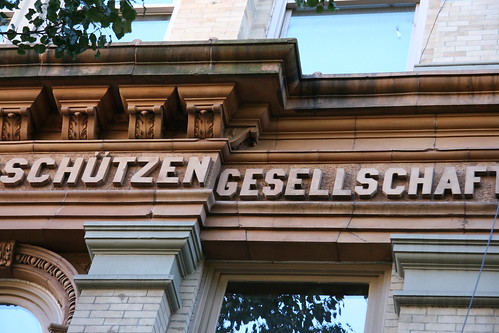 Sophie Hoeller Signs of the East Village’s former notoriety as Little Germany can still be found in pockets around the community. Here, the former German-American Shooting Hall at 12 St. Marks Place.
Sophie Hoeller Signs of the East Village’s former notoriety as Little Germany can still be found in pockets around the community. Here, the former German-American Shooting Hall at 12 St. Marks Place.Oktoberfest – the 200-year-old homage to German beer – and arguably the most identifiably German thing next to sauerkraut, kicked off this weekend. But you don’t have to cross the Atlantic to partake. In fact, you don’t even have to leave the neighborhood.
Most of us are well aware of the Lower East Side’s Jewish roots, but many don’t know that what is now called the East Village used to be known as “Kleindeutschland,” or Little Germany, home to German grocery stores, restaurants, beer gardens, libraries, theaters, shooting clubs, schools and churches.
Read more…
First Person | The Dangers of Dooring
By BILL MILLARDThe paint and concrete have barely dried on the East Village’s new bicycle lanes, but already business owners and residents are concerned about new dangers for neighborhood cyclists. The new lanes on First and Second Avenue pose a range of potential hazards from open car doors to riders who go against the flow of traffic.
Christopher Feltman, co-manager of the Second Avenue bike shop NYC Velo, estimates that wrong-way bike traffic has increased at least fivefold since the lanes were installed this summer.
“As a rider, I think it’s been worse,” he says of safety on Second Avenue since the lanes were added. “Because they painted it green, a lot of people take that as ‘I can go both ways on it.’”
Read more…
Conversation | On Bars and Noise
By THE LOCALEarlier this week, we wrote about a meeting of the state liquor authority committee of Community Board 3, where neighborhood residents successfully opposed the granting of a liquor license to a diner on Avenue A. One reader, Josef, commented in the forums:
Who are these people? Obviously they do not deserve to live in such a cool neighborhood. There are thousands and thousands of people who would love to move to the East Village and revel in its bars, restaurants, noise, traffic, and graffiti. Instead, the best hood for partying in the city winds up populated by shrinking violets with sensitive eardrums and early bedtimes.
Later in the week, we posted a story about the Ninth Precinct Community Council Meeting where at least 25 people showed up to voice their complaints about noise and fighting outside East Village bars.
As the weekend approaches – with Oktoberfest celebrations and other events planned – we’d like to know what you think.
Are complaints about noisy bars and congested streets overblown?
Or do residents have a legitimate expectation that business owners control the riff-raff?
Let us know.
On Brunch | At Westville East
By TREVOR LEBTrevor Leb is a brunch aficionado in the East Village and founder of the popular New York brunch blog, I Heart Brunch.
There are certain places you can’t help but love. You know, like your go-to bar with the really good vibe or the neighborhood restaurant with that dish that you love. For me, Westville East is one of those places, especially for weekend brunch.
With roots in the West Village, Westville East has been turning first time customers into fans since opening on the East side in 2007. The restaurant’s friendly and welcoming staff adds to its theme of “simplicity,” which shines through in both its fresh eclectic American cuisine and its décor. Small antiques and posters from yesteryear delicately accent the interior space, while the food highlights locally sourced, high quality ingredients prepared in a simple and tasteful manner.
Read more…
A Preview of Fall Restaurant Openings
By KIM DAVISIt’s the time of year when people who write about restaurants, and those who can still afford to eat in them, start salivating over the season’s new openings.
Although dozens of debuts are scheduled, including some high profile new projects by Aquavit’s Marcus Samuelsson in Harlem and Jonathan Benno, formerly of Per Se, at the Lincoln Center, all seems quiet on the East Village front. This may reflect market saturation in a neighborhood which is now one of the city’s top dining destinations, or just the fact that bars and restaurants open here year round.
Read more…
Lots of Tagelach, Only One By Moishe’s
By CAROLYN STANLEYTonight, all over the world, Jews will complete their last meal of the year with a pinch of tagelach, then end their Yom Kippur fast with another sweet bite.
Recipes for the traditional sticky, honey-coated amalgamation of pastry dough, nuts and fruit piled loosely into pyramids are passed down through generations. But, Moishe Perl says, his tagelach is the best.
“The other companies who make it don’t know how to make it,” said Mr. Perl, the Moishe in Moishe’s Home Made Kosher Bake Shop on Second Avenue. And he’s not sharing his recipe. But, he revealed, his version involves four kinds of nuts, two kinds of dried fruit and a special kind of flour.
Many different cultures have a version of tagelach, and its hyper-sweet taste is not for everyone. But people cling to traditions, and so Moishe’s was a busy bakery this last few weeks as Jews celebrated Rosh Hashanah and now, tonight, Yom Kippur, the end of the 10-day-long Jewish new year celebration.
Yom Kippur is a day of prayer, reflection, atonement, and, for the observant, a 25-hour fast begins just before sundown tonight. Two meals bookend the fast: an afternoon feast to fuel up for the long day ahead, and the breaking of the fast shortly after sundown Saturday.
That’s where Moishe’s tagelach comes in.
Mr. Perl said the dish is filled with symbolism: “We all have our ups and downs, we go nuts sometimes, we have our dry moments.” Covering the mixture in honey is a way to “make everything sweet,” or make peace with the events of the year.
Read more…



